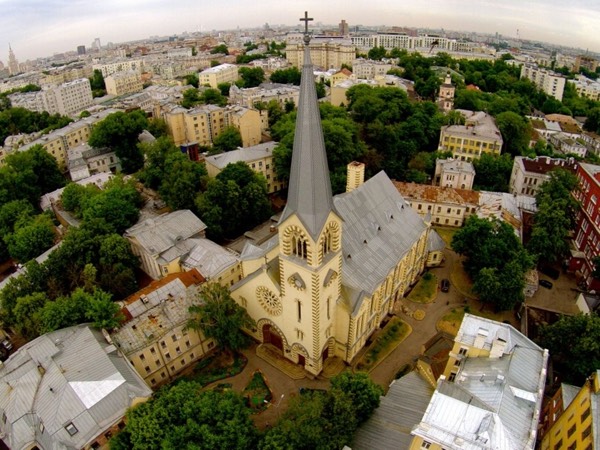The Cathedral of the Holy Apostles Peter and Paul
The Cathedral of the Holy Apostles Peter and Paul is a functioning church, the oldest Lutheran parish in Russia. The construction of the shrine became possible thanks to the active actions of the Russian Lutheran community, at whose expense the estate of Princes Lopukhin was bought, and with the financial support of the Russian emperor Alexander I and King Frederick of Prussia were rebuilt accordingly.
The cathedral building was consecrated in 1819, and the sounds of the traditional Lutheran organ were first heard in it about twenty years later. Towards the middle of the 19th century, due to the expansion of the Lutheran Moscow community, the church was reconstructed according to a project authored by one of the founders of the Moscow Architectural society — Alexander Adolfovich Meingard. The building received features traditional for the neo-Gothic architectural style. The bell for the cathedral tower was personally donated by Kaiser Wilhelm I.
After 1917, all the property of the church was nationalized, and valuables were seized. It was possible to preserve the altar Bible of 1665, the Baroque altar of 1764, the organ and cross of the bishop. All relics are now in the [Peter and Paul Cathedral] (https://kudago.com/spb/place/petropavlovskaya-krepost/) in St. Petersburg. The church was empty and began to collapse. In order not to lose the building, they decided to place the Moskino cinema in it. Then the cathedral was given to the Diafilm studio, which rebuilt the historic building for its own needs and destroyed valuable interiors.
The revival of the community (which never ceased to exist) in the temple took place at the end of the 20th century. The restoration of the cathedral began in 1997. Gradually, the community demolished excess walls, restored the interiors, decor details, and completely restored the lost spire.
The special pride of the cathedral is the organ. The historical instrument, purchased by the church in 1892, was taken to Novosibirsk during the Great Patriotic War, where it was destroyed. Revived in the late 90s, the community received another historical instrument, the Wilhelm Sauer organ. Today it is considered one of the oldest bodies in Russia and one of the four church bodies in Moscow.
The cathedral hosts regular organ music concerts, and the organ accompanies festive and Sunday services, festivals and performances by Russian and foreign performers.
Address
per. Starosadsky, 7/10, bldg. 10
Address
per. Starosadsky, 7/10, bldg. 10
Address
per. Starosadsky, 7/10, bldg. 10
Phone
+7 495 628-53-36
Phone
+7 495 628-53-36
Phone
+7 495 628-53-36
Website
The Cathedral of the Holy Apostles Peter and Paul
Website
The Cathedral of the Holy Apostles Peter and Paul
Website
The Cathedral of the Holy Apostles Peter and Paul
Source
https://kudago.com/msk/place/kafedralnyj-sobor-svyatyh-apostolov-petra-i-pavla/
Source
https://kudago.com/msk/place/kafedralnyj-sobor-svyatyh-apostolov-petra-i-pavla/
Source
https://kudago.com/msk/place/kafedralnyj-sobor-svyatyh-apostolov-petra-i-pavla/


